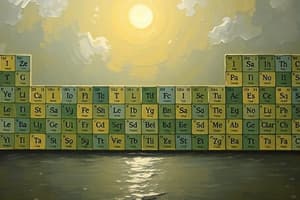Podcast
Questions and Answers
What is the characteristic of liquids compared to solids and gases?
What is the characteristic of liquids compared to solids and gases?
- Liquids have a fixed shape and volume.
- Liquids have neither a fixed shape nor volume.
- Liquids have both a fixed shape and take the shape of their container.
- Liquids have a fixed volume but take the shape of their container. (correct)
What defines a saturated solution?
What defines a saturated solution?
- A solution that contains no solute.
- A solution that holds more solute than it can dissolve.
- A solution that contains the maximum amount of solute a solvent can dissolve at a given temperature. (correct)
- A solution that can dissolve more solute.
What do acids release when dissolved in water?
What do acids release when dissolved in water?
- Hydrogen ions (H+) (correct)
- Hydroxide ions (OH-)
- Oxygen ions (O2-)
- Salt particles
Which statement best describes the first law of thermodynamics?
Which statement best describes the first law of thermodynamics?
What is stoichiometry primarily concerned with?
What is stoichiometry primarily concerned with?
What defines the atomic number of an element?
What defines the atomic number of an element?
Which type of bond is formed when atoms share electrons?
Which type of bond is formed when atoms share electrons?
Which statement about isotopes is true?
Which statement about isotopes is true?
In which part of the periodic table are elements with similar properties grouped?
In which part of the periodic table are elements with similar properties grouped?
Which of the following factors does NOT affect the rate of a chemical reaction?
Which of the following factors does NOT affect the rate of a chemical reaction?
What occurs during a chemical reaction?
What occurs during a chemical reaction?
Which description best characterizes metals?
Which description best characterizes metals?
What is the mass number of an atom?
What is the mass number of an atom?
Flashcards
States of Matter
States of Matter
Solids have fixed shape/volume; liquids have fixed volume but take container shape; gases have neither.
Phase Changes
Phase Changes
Changes of state that involve energy transfer; includes melting, freezing, evaporation, condensation, sublimation, and deposition.
Solutions
Solutions
Homogeneous mixtures of solute and solvent; solute dissolves in solvent.
pH Scale
pH Scale
Signup and view all the flashcards
Stoichiometry
Stoichiometry
Signup and view all the flashcards
Atom
Atom
Signup and view all the flashcards
Proton
Proton
Signup and view all the flashcards
Isotope
Isotope
Signup and view all the flashcards
Atomic Number
Atomic Number
Signup and view all the flashcards
Chemical Bond
Chemical Bond
Signup and view all the flashcards
Ionic Bond
Ionic Bond
Signup and view all the flashcards
Reactant
Reactant
Signup and view all the flashcards
Study Notes
Atomic Structure
- Atoms are the fundamental building blocks of matter.
- Atoms consist of a nucleus containing protons and neutrons, surrounded by orbiting electrons.
- Protons have a positive charge, electrons have a negative charge, and neutrons have no charge.
- The number of protons in an atom's nucleus defines its atomic number, which determines the element.
- The mass number of an atom is the sum of protons and neutrons.
- Isotopes are atoms of the same element with different numbers of neutrons.
- Atomic orbitals describe regions of space where electrons are likely to be found.
Periodic Table
- The periodic table organizes elements based on their atomic structure and properties.
- Elements are arranged by increasing atomic number.
- Elements with similar properties are grouped in vertical columns called groups or families.
- Elements are also arranged in horizontal rows called periods.
- Elements in the same group have similar valence electron configurations, leading to similar chemical properties.
- Metals typically have high thermal and electrical conductivity, are lustrous, and are malleable.
- Nonmetals typically are poor conductors of heat and electricity and are often brittle.
- Metalloids exhibit properties of both metals and nonmetals.
Chemical Bonding
- Chemical bonds are forces that hold atoms together in molecules or compounds.
- Ionic bonds form between a metal and a nonmetal when one atom transfers electrons to another.
- Covalent bonds form between nonmetals when atoms share electrons.
- Metallic bonds occur between metal atoms, where electrons are delocalized (shared among many atoms).
- The strength of bonds affects the properties of substances.
Chemical Reactions
- Chemical reactions involve the rearrangement of atoms to form new substances.
- Chemical reactions are represented by chemical equations.
- Reactants are the substances that undergo change, and products are the new substances formed.
- The law of conservation of mass states that mass is neither created nor destroyed in a chemical reaction.
- Chemical reactions can be classified into different types, such as synthesis, decomposition, single displacement, double displacement, and combustion.
- Factors affecting reaction rate include temperature, concentration of reactants, surface area, and presence of catalysts.
States of Matter
- Matter exists in three primary states: solid, liquid, and gas.
- Solids have a fixed shape and volume, liquids have a fixed volume but take the shape of their container, and gases have neither a fixed shape nor volume.
- Changes of state involve energy transfer.
- Phase changes include melting, freezing, evaporation, condensation, sublimation, and deposition.
Solutions
- Solutions are homogeneous mixtures of two or more substances.
- The solvent is the dissolving medium, and the solute is the substance being dissolved.
- Solubility describes the ability of a substance to dissolve in a given solvent.
- Factors affecting solubility include temperature, pressure, and nature of solute and solvent.
- Solutions can be categorized as saturated, unsaturated, or supersaturated based on the amount of solute dissolved.
Acids and Bases
- Acids are substances that release hydrogen ions (H+) when dissolved in water.
- Bases are substances that release hydroxide ions (OH-) when dissolved in water.
- The pH scale measures the acidity or basicity of a solution.
- Acids and bases react with each other in neutralization reactions to form water and a salt.
- Indicators are substances that change color in the presence of acids or bases.
Stoichiometry
- Stoichiometry involves calculating the quantities of reactants and products in chemical reactions.
- Balanced chemical equations are used to determine mole ratios.
- Mole ratios are used to convert between moles of reactants and products.
- Stoichiometry calculations are essential for quantitative analysis in chemical reactions.
Thermodynamics
- Thermodynamics is the study of energy and its transformations.
- The first law of thermodynamics describes the conservation of energy.
- The second law of thermodynamics describes the tendency of systems to become more disordered (entropy).
- The third law of thermodynamics describes the behavior of systems at absolute zero.
Studying That Suits You
Use AI to generate personalized quizzes and flashcards to suit your learning preferences.




